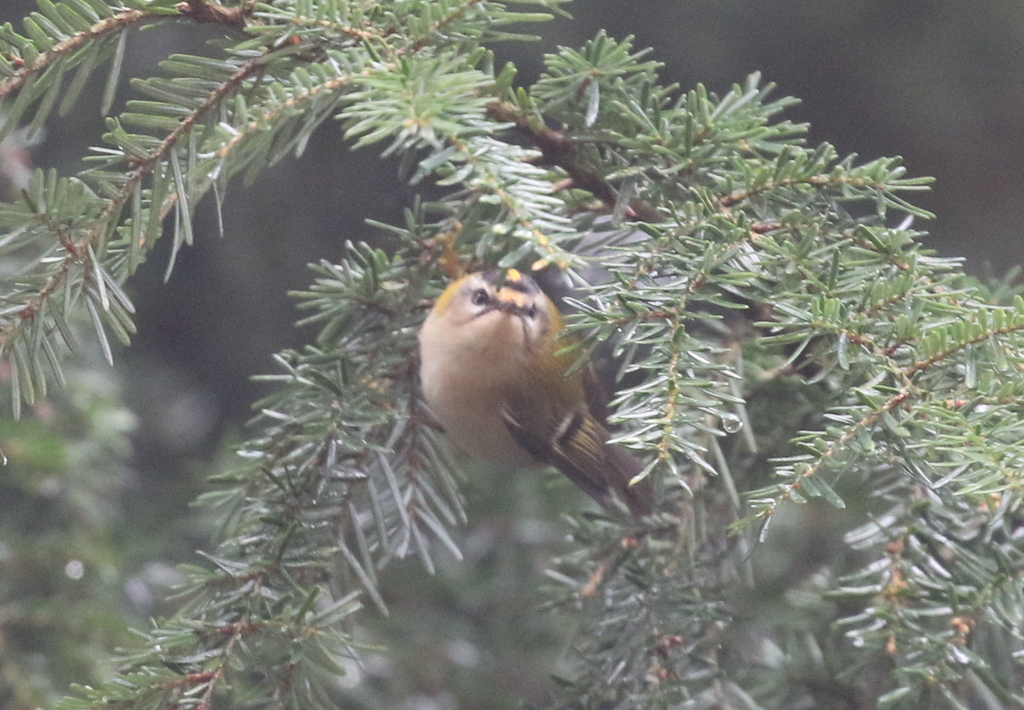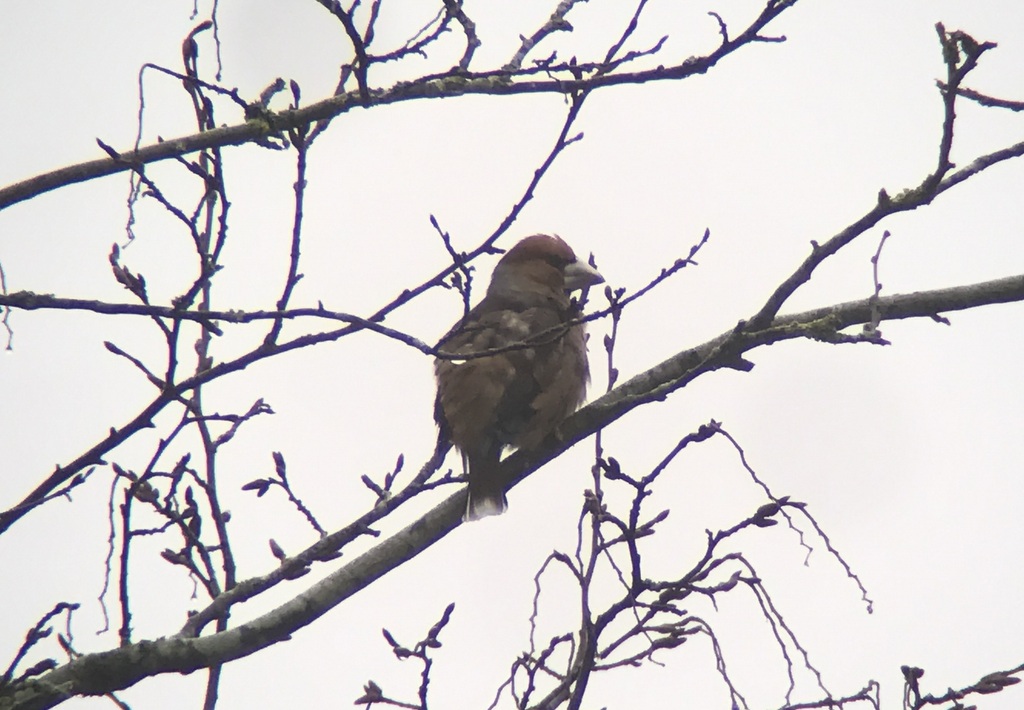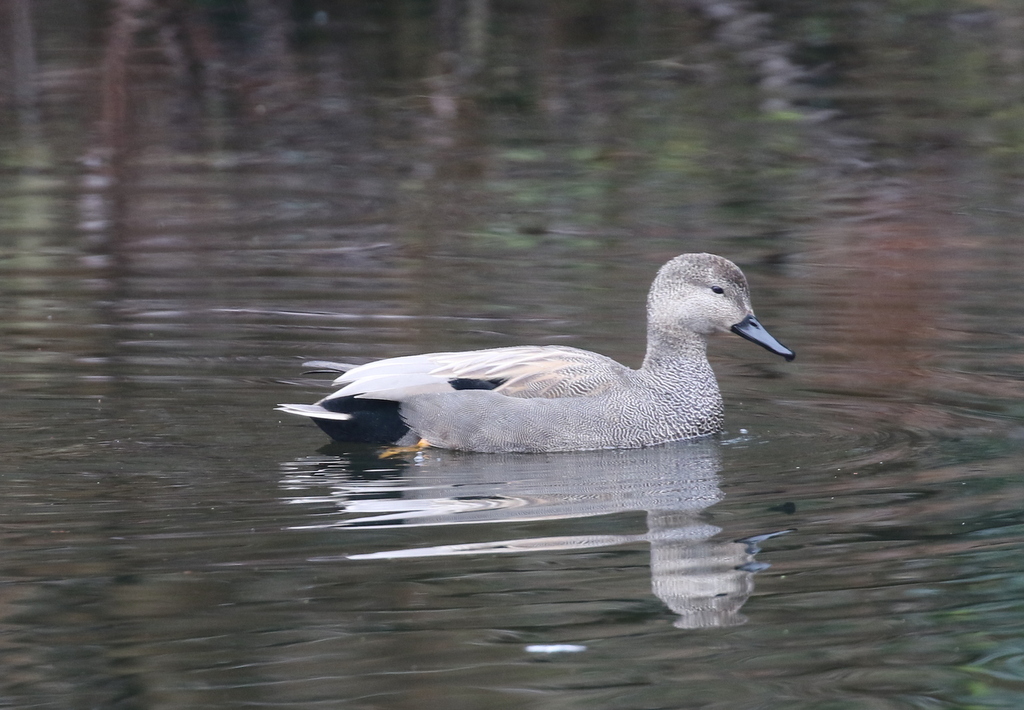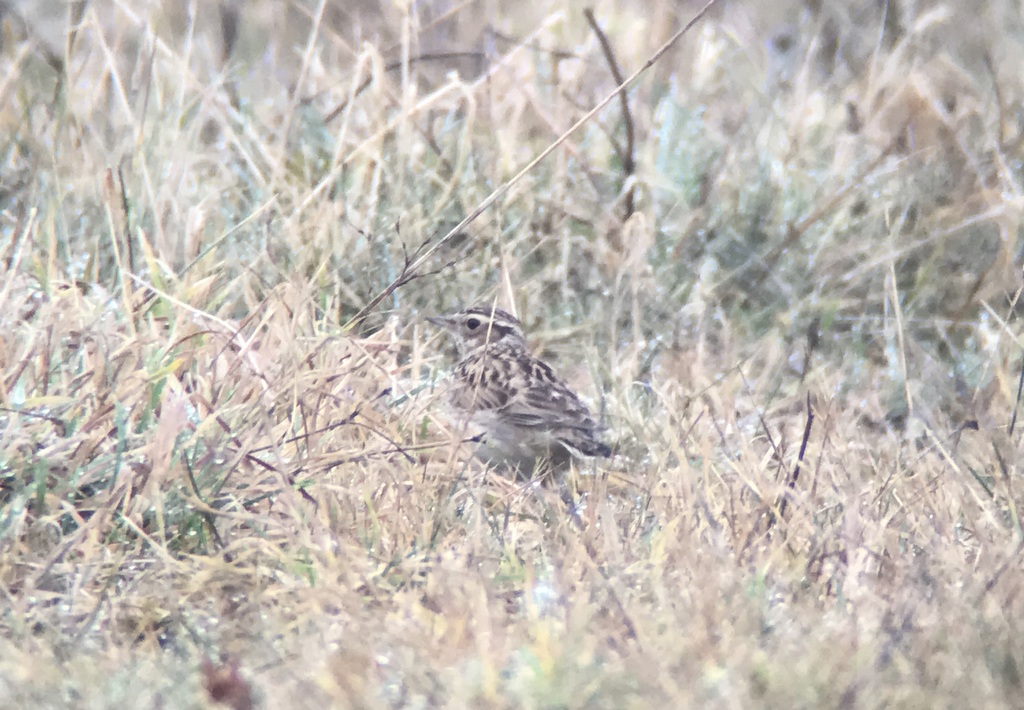A Private Tour in the Brecks today – with some specific target species to look for, rather than a general day’s birding. The weather forecast was poor – heavy rain on and off all day – to the extent that there were even questions as to whether we should go at all. However, as we have seen so many times, all is not as bad as it seems, particularly where Met Office forecasts are concerned! It was still damp, with mist or very light drizzle for most of the day, but nowhere near as bad as forecast. We went out anyway and saw lots of good birds regardless. It is amazing what you can find when you get out…
Our first destination was Santon Downham, where we would be spending the first part of the morning looking for Lesser Spotted Woodpecker. A Stock Dove was whooping from the trees as we got out of the car, another sign that spring is on its way. The feeders in the garden down by the bridge held a few finches and tits, and a Nuthatch flew off, up into the alders by the river as we passed.
It was drizzling with rain as we walked along the river bank. A pair of Siskins were feeding on the alder cones and catkins that had fallen onto the path and flew off ahead of us as we approached. A flock of Long-tailed Tits flitted through the trees over our heads. A Redwing flew up into the alders on the other side of the river. A Reed Bunting was singing from the reeds and a Marsh Tit was signing from the poplars a little further on.

As we rounded the corner, we heard a woodpecker call from the trees. It called again – yes, it was a Lesser Spotted Woodpecker! It was high in the back of the poplars and we had to adjust our position to try to see it, but just caught sight of it as it flew. It landed in some birches further back, out of view, calling again. It was on the move all the time, not staying still for even a second. Then it flew up into the bare branches in the top of another poplar behind where we just managed to get the scope onto it as it dropped back out of view. But it was all too quick to get everyone onto it.
The Lesser Spotted Woodpecker called again a couple of times and then, after just a minute or so, we picked it up flying out towards us. It looked like it might go high over our heads, but fortunately it turned and dropped into the very top of one of the poplars. We had a good view of it through binoculars this time, and even got everyone onto it in the scope, at least briefly, before it flew again and dropped down into the alders on the other side of the river.

At least we had seen it, but it felt like that might be it. We stopped to watch some of the other birds. There were lots of Redwings in the trees today and a flock of about twenty Siskins flew back and forth across the river.
Then we caught sight of some movement and watched as the Lesser Spotted Woodpecker flew across and landed low down on one of the trunks on the near side of the bank of trees. This time we had a great view of it as it pecked and probed in the bark. It was the female, with a dark rather than red crown, and we could now appreciate just how small it was – only around the size of a sparrow.
We watched the Lesser Spotted Woodpecker for several minutes, gradually working its way up the tree, before it flew off up high into the alders and out of view. A Great Spotted Woodpecker then appeared in the trees nearby and we got that in the scope too. We could see it was much bigger, with an obvious red patch under the tail.
Very pleased with getting such good views of our first target, we headed back along the path. At the garden by the bridge, a couple of Bramblings had appeared at the feeders but flew off as a car passed. We made our way up to the churchyard to look for our next target – Firecrest. But it was still drizzling at this stage and all was quiet. There were not even any tits or Goldcrests in the trees, just a noisy Nuthatch.
The Parrot Crossbills have been very elusive at times in recent weeks and with the weather today too, we didn’t hold out much hope of seeing them. We drove along to the car park north of the level crossing to have a look anyway. They haven’t been drinking in the car park recently, but have been coming down at times to the ditches in the cattle fields, so we had a walk round that way.
This is usually a good area for Woodlark but there was not even any sign of those this morning. We did find a pair of Treecreepers climbing the trees in the edge of the paddock and a couple of Jays which flew off ahead of us.
There was no sign of the Parrot Crossbills at St Helens either, nor could we find any Woodlark here today. A pair of Mistle Thrushes were feeding out in the cultivated strip and we could hear a Grey Wagtail singing and looked across to see it perched on the handrail of the footbridge. A quick look down at the river failed to produce anything of note either.
We decided to have an early lunch back at the level crossing car park then afterwards walked back along the road to the bridge. A Kestrel flew through the trees, our first of the day. A Green Woodpecker laughed at us in the distance. But there was no sign of much else of note here, so we decided to move on and try something different.
When we got to the car park at Lynford Arboretum, we walked across to look in the fir trees. We had only just started to say that this is sometimes a good place for Firecrest, when a tiny green bird flitted into the bare branches of a small deciduous tree in front of us. A Firecrest – right on cue!

The Firecrest flew up into a fir tree nearby and we watched as it flitted around among the branches for several minutes, giving us a great view of its head pattern, the prominent white supercilium and black eye stripe lacking in Goldcrest. It dropped back into some low fir trees and disappeared but a couple of seconds later we heard it singing. We walked over to find it above our heads in a beech tree by the road. Having missed it at Santon Downham earlier, it was all the better to catch up with Firecrest here now.
Walking down through the Arboretum, we stopped at the gate to look at the feeders. The fat balls were coated in Blue Tits feeding feverishly. The ground was coated with birds too, coming down to the seed sprinkled liberally among the leaves. A Marsh Tit dropped in among all the Great Tits. There were several Chaffinches feeding in the beech leaves too and a couple of Bramblings appeared with them, a brighter orange male and a duller female.

Down at the bottom of the hill, there was no seed put out for the birds at the bridge today, so it was rather quiet. A Goldcrest was singing high in a fir tree. We decided to have a look round by the lake first instead. There were lots of Siskins along the path and here too they were feeding mostly on the ground today. We stopped to watch two bathing in a wet marshy area under the trees. Three Nuthatches were chasing each other through the branches.

We had already had a quick scan of the hornbeams out in the paddocks from the start of the path, but now we heard a distinctive metallic ‘ticking’ call coming from the trees. We found a convenient viewing gap and looked across to see at least three Hawfinches chasing each other through one of the hornbeams. There appeared to be two brighter males and a female. As the males flew through the branches, they spread their tails, showing off the white tip. This is the start of their spring display, a precursor to pairing up, something great to watch.
As the chasing subsided, one of the Hawfinches then stopped in the top of the tree and started to preen. Here we could get a really good look at it, through the scope. We could see the massive bill and head, powerful enough to crack a cherry stone!

After watching the Hawfinches for several minutes, they moved further back into one of the other trees. We continued on round the lake. There were a few wildfowl on here as usual – a couple of Mute Swans, a single Greylag with several Canada Geese, and a couple of pairs of Gadwall. We were in agreement today, that Gadwall really are an underrated duck compared to some of their gaudier cousins!

Firecrest and Hawfinch were our main target species at Lynford this afternoon, so having caught up with them so quickly, we had a bit more time to play with. We decided to head off into the forest again and have another go to see if we could find any Woodlark.
On our way, we stopped to admire a large flock of thrushes in a field, a mixture of Fieldfares and Redwings. The Redwings were easily spooked and kept flying up into the trees nearby, while the Fieldfares largely continued to feed unconcerned. A single larger Mistle Thrush was lurking at the back too.

We parked at the start of a forest ride, by a large clearing, and as soon as we got out of the car we could hear a Woodlark calling, a distinctive ringing, double ‘tu-lee’. We looked over to see it perched high in a tall bare tree, left behind when the plantation was clearfelled. Through the scope, we could see its short crest and bold pale supercilium. It even gave a short burst of its mournful song. The weather had improved a little through the afternoon, but it was not what we were expecting on such a dull and damp day!
As we walked round, there were more birds in the other trees in the clearing. There were several Yellowhammers including some smart yellow-headed males. A little flock of 6-7 Lesser Redpoll flew up to join them. A Green Woodpecker flew across and landed in the trees on the far side of the clearing.
A little further on, we could hear another Woodlark singing and looked across to see it song-flighting, fluttering over the clearing with rounded bat-like wings and short tail. It landed in a tree at the back with more Yellowhammers, where we got a distant look at it through the scope, before one of the Yellowhammers chased the Woodlark off. We watched the two of them fly round and the Woodlark dropped down to the ground on the edge of the path, a little further on.

We made our way over quietly and had great views of the Woodlark through the scopes, feeding on the ground. We could see the way the pale supercilia met at the back of the neck in a shallow ‘v’.
It was great to catch up with Woodlark finally, having missed them earlier in the day. That was a great way to wrap things up and we decided to head for home. With all the concerns earlier about the weather forecast, it was remarkable how well we had done today. Well worth coming out after all!
















